-
Posts
2,351 -
Joined
-
Last visited
Content Type
Profiles
Forums
Store
Help Articles
Posts posted by Patrick S
-
-
Thank you for the recipe, Jensen.
It occurred to me after I asked the question that I could do the lemon curd filling like a lemon pie filling -- cooking cornstarch with water, then adding the other ingredients.
-
I need a recipe to use as a filling in a 3 tier wedding cake (unexpected request, has to be ready saturday). I'd like something that sets a little firmer than a typical curd. Anyone have a recipe they've used in this way?
Thanks in advance!
-
Does any one know if mixing these two ingredients would deliver invert sugar and if so how much would be the ratios?
The ratio would be precisely 1:1, i.e. an equimolar mixture of fructose and glucose. Something I was wondering about last time this came up is whether you can buy high-fructose corn syrup in retail quantities, because it is 1) dirt cheap due to gov't corn subsidies, and 2) is essentially the exact same thing as invert sugar, the only major difference being that HFCS is not exactly 50/50 glucose/fructose -- HFCS 55 is 55% fructose and 45% glucose, and HFCS 42 is . . . you get the idea. They are basically the same thing, just made in different ways. Invert sugar is made by hydrolyzing sucrose into fructose/glucose, whereas HFCS is made by partially converting a glucose syrup to fructose.
-
Does pasteurized milk count as raw, or cooked?
Undoubtedly people have different ideas about what constitutes cooking, but according to the wikipedia entry for Raw Food Diet:
The exact definition of raw food varies, but the general consensus is that a raw food is a food that has not been altered by any method that would change its basic chemical structure through heating it over 118 degrees Fahrenheit (48˚C).Since the minimal temperature for pasteurization is 140F, pasteurized milk would be considered a cooked food on that definition.
-
2. Life force (as seen through Kirlian photography) of raw food is beneficial.
Bwaaahaaahaa!
 That would have been a lot more sensible a century and a half ago, before we had a basic understanding of electrical phenomena. All that Kirlian photos show are corona discharges, which are created when you pass electric current through an object, making it in effect an electrode. The electricity ionizes the air around the "electrode," the ionized gas emits UV light, and that is what creates the corona, or "aura." That hypothesis is proven by, among other things, the fact that coronae don't appear when you do the procedure in a vacuum -- no air to be ionized, no corona. Also, corona discharges can be created using all kinds of conducting materials, and are not even a unique property of living or once-living materials.
That would have been a lot more sensible a century and a half ago, before we had a basic understanding of electrical phenomena. All that Kirlian photos show are corona discharges, which are created when you pass electric current through an object, making it in effect an electrode. The electricity ionizes the air around the "electrode," the ionized gas emits UV light, and that is what creates the corona, or "aura." That hypothesis is proven by, among other things, the fact that coronae don't appear when you do the procedure in a vacuum -- no air to be ionized, no corona. Also, corona discharges can be created using all kinds of conducting materials, and are not even a unique property of living or once-living materials. -
Is it dangerous to eat the fuzzy stuff that grows on food after it has been in the fridge for a while? Or could it actually be healthful, since I think I remember reading that penicillin might come from it.
I never eat food in such state a state, but think I may have eaten bread that had the tiniest of splotches of mold starting to form (with no ill effects).
Bonus points for actually describing what the fuzzy stuff actually is
 .
.The fuzzy stuff is mold. It is made up of the thread-like mycelia of various fungi. Some molds are dangerous, for instance those which produce mycotoxins, and some are harmless.
-
The pizza dough recipe in the latest Cook's Illustrated works reliably, has a great texture (crisp outside, soft inside), is ready to bake in no time, and is easy to form. It uses a combination of AP and cake flour, and does not include any fat.
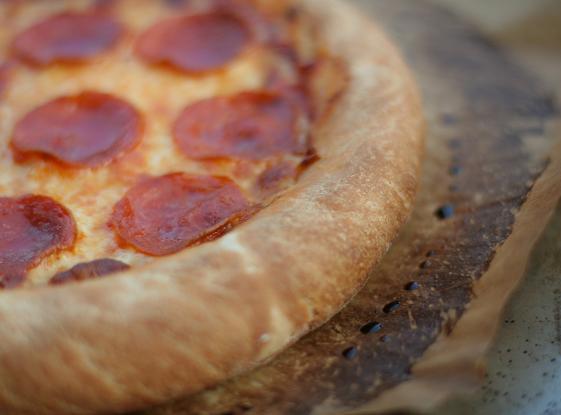
I've also used their older recipe, which calls for bread flour and includes olive oil, and it works great as well, but is harder to get thin because of the higher gluten content.
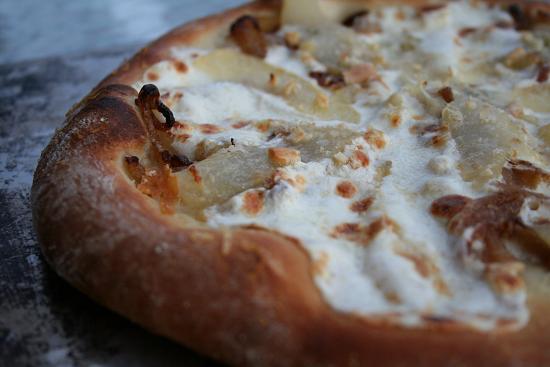
-
Ah yes, one other thing. The stereotypes you mentioned are just that. Stereotypes. When I was a vegan I was *not* a skinny, dredlocked (and what's wrong with dredlocks anyway?), drug using "freak."
And most drug-loving, dredlocked freaks aren't vegans, much less raw food devotees.
-
Awesome, thanks!
Another question - is it easy to make all this stuff without a stand mixer? I saw in the pate choux thread that they used a stand mixer with a paddle. I almost got a stand mixer a while ago, but I've found a lot of things can be done in my food processor, and stand mixers are a bit pricey and take up a good amount of space.
There are many things that are easier with a stand mixer, but there are very few things that really require one. You can definitely make pate a choux by hand, or with a hand mixer. Everything that has been listed on this thread can be done with a hand mixer.
-
Sure, here's a pastry cream recipe from a Herme book that I use all the time:
2C whole milk
1 vanilla bean (or 2t extract)
6 large yolks
1/2C sugar
1/3C cornstarch
3T unsalted butter (room temp)
1. Scrape the vanilla seeds into a medium pot, add the milk, bring to a boil, take off the heat and let stand for 10 minutes.
2. Whisk the sugar, yolks, and cornstarch together in a seperate bowl. While whisking, slowly add the hot milk to the yolk mixture. When all the milk has been added, pour everything back into the pot.
3. Put your pot on medium, medium-high heat, stirring constantly, bring to a boil, and boil for a minute or so. Take the pot off of the heat.
4. Let the pastry cream cool until it is about 140F, and stir in the butter.
If you want chocolate, stir in about 3-4oz of bittersweet chocolate at the end of step 3. If you want coffee flavor, add about 1T (or to taste) instance espresso powder in step 1.
-
Patrick, is that black background a setting on your camera? I love the way that picture looks, but I don't know how to achieve that effect myself.
The background is a black, plastic serving tray, and the picture is shot at such an angle that the tray fills the background. The background is blurred quite a bit because I used a large aperture setting (I think this shot was at F1.4). That helps make the background homogenous and smooth.
-
Dear Patrick,
Please describle what Jean Phillipe Maury's dessert in the glass was like.
The description for this dessert that is given in the JPM thread is coconut mousse, candied pineapple, kalamansi coulis, lime dacquoise, crispy coconut. However, I didn't discern any crispy coconut. I think the 'Exotic' I got was different -- the one in the JPM thread is a molded dessert, not a dessert in a glass.
-
I had some vanilla bean ice cream with Pirouette cookies.

-
Let me say again how awesome that was. Its got me really interested in doing some layered desserts in glasses. An idea I'm pondering right now is layers of pineapple gelee and coconut milk mousse, with lime creme brulee on the bottom.
-
Geez, Patrick! It all looks deadly, but that ice cream is a thing of beauty, with its little caramel bits. How did you keep them from melting into the ice cream?
Thanks, Abra.
 Actually, the little bits are minced orange zest. The caramel is all dissolved in the base. Its 96 and humid here today -- I think a little more ice cream may be called for.
Actually, the little bits are minced orange zest. The caramel is all dissolved in the base. Its 96 and humid here today -- I think a little more ice cream may be called for. -
I've read through this thread with great interest, beeing a big pizza lover.
I'm pretty sure that there is a kind of "manifesto" for making real italian pizza, that says things about max diameter of the crust, banned ingredients (I actually believe that no fat what so ever is allowed in "real" italian pizza dough), ovent types, heat, baking method (no rolling pins allowed) etc etc etc.
I didn't see any reference to it in the thread and was unfortunately not able to dig up my reference on short notice. Does anyone else know what Im talking about?
Yes, there is a Denominazione di Origine Controllata for Italian pizza, which specifies the official recipes for verace pizza napoletana. According to Wikipedia:
Neapolitan pizza (pizza Napoletana). According to the rules proposed by the Associazione vera pizza napoletana and other sources quoted by the BBC,[7] and the legal EU document with the Vera Pizza Napoletana Specification in translation, the genuine Neapolitan pizza dough consists of Italian wheat flour (type 0 and/or 00), natural Neapolitan yeast or brewer's yeast, and water. For proper results, strong flour with high protein content (as used for bread-making rather than cakes) must be used. The dough must be kneaded by hand or with a low-speed mixer. After the rising process, the dough must be formed by hand without the help of a rolling pin or other mechanical device, and may be no more than 3 mm (1/8 in) thick. The pizza must be baked for 60–90 seconds in a 485 °C (905 °F) stone oven with an oak-wood fire. When cooked, it should be soft and fragrant. Neapolitan pizza has also gained in Italy the status of "guaranteed traditional speciality". This admits only three official variants:Pizza marinara: with tomato, garlic, oregano and oil;
Pizza Margherita: tomato, mozzarella in fillets, basil and oil;
Pizza Margherita Extra: tomato, buffalo mozzarella from Campania in fillets, basil and oil.
-
Here are a few things I've made since the last time I posted to this thread.
Orange-caramel ice cream with orange caramel sauce.

Amaretto cheesecake with Amaretto caramel.
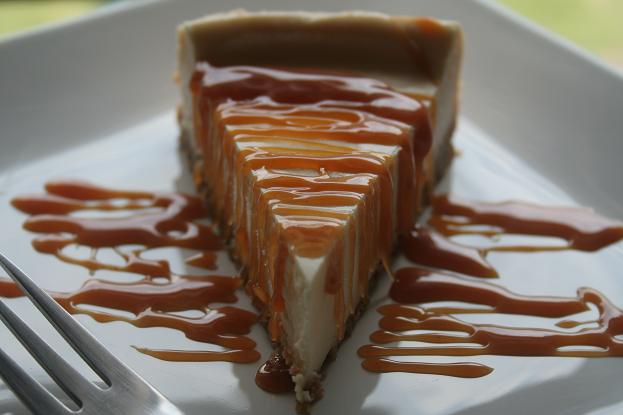
Lemon sponge with Orange Mousseline Buttercream.
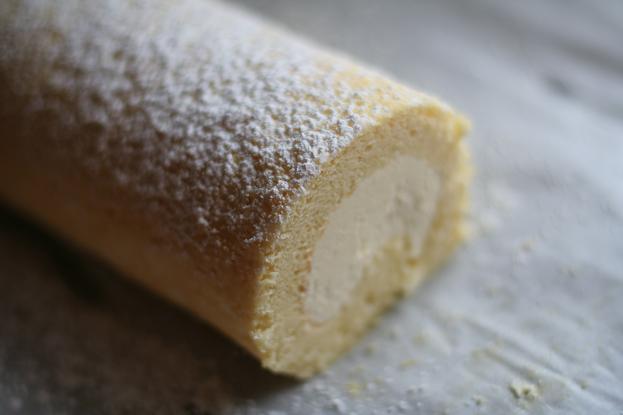
The "Exotic" from Jean Phillipe Maury at the Bellagio in Vegas.
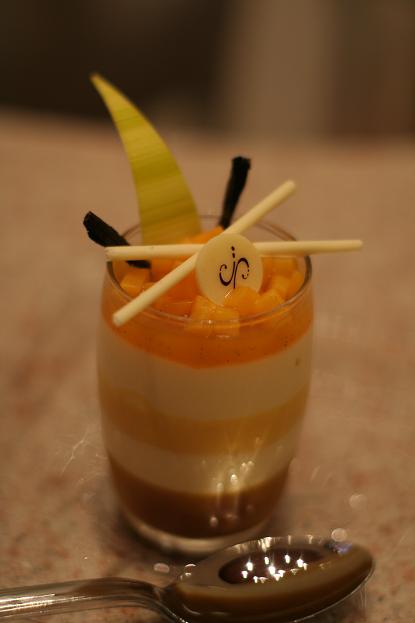
-
This is sort of an old thread, but in the latest issue of Cook's Illustrated, they gave a recipe for the perfect pizza crust. Their secret is using some cake flour in the recipe.
Here is a photo demo and the recipe;
http://www.slashfood.com/2006/06/14/cookin...zza-margherita/
1 1/4 tsp instant yeast
1 cup water, room temperature
1 3/4 cups (8 3/4 oz) all-purpose flour, plus more for work surface
1 cup (4 oz) cake flour
1 1/2 tsp salt
2 tsp sugar
I've used this crust recipe several times now, and like it quite a bit. Crisp outside, soft inside. I press it out with a "rim," so you eat the slice and get a peice of crust left over for dipping in sauce.

Good to hear Patrick. I made it tonight actually, along with their sauce. I believe I had some bad yeast because mine resulted in a thin crust, nothing like your's. I liked the flavor, but it did not puff around the edges like that.
The sauce was not bad, but I have had better. I am one for just using cheeses and a few ingredients anyway. I just wanted to try it. I will say it was simple to make.
I will give it another try and proof my yeast next time.
As far as sauce goes, I actually prefer the cooked, spicier marinara-like tomato sauces to the simpler, uncooked sauce that is traditional on Margherita pizza. Did your doughs double in size? If so, your yeast was still good.
Do you bake your pizzas on a stone? I bake my pizzas on a stone that has preheated for an hour on the bottom rack, and have always had good rise in the oven.
-
This is sort of an old thread, but in the latest issue of Cook's Illustrated, they gave a recipe for the perfect pizza crust. Their secret is using some cake flour in the recipe.
Here is a photo demo and the recipe;
http://www.slashfood.com/2006/06/14/cookin...zza-margherita/
1 1/4 tsp instant yeast
1 cup water, room temperature
1 3/4 cups (8 3/4 oz) all-purpose flour, plus more for work surface
1 cup (4 oz) cake flour
1 1/2 tsp salt
2 tsp sugar
I've used this crust recipe several times now, and like it quite a bit. Crisp outside, soft inside. I press it out with a "rim," so you eat the slice and get a peice of crust left over for dipping in sauce.

-
I was in Vegas this past weekend, and in between drinking and partying I managed to visit JPM's twice. On the first visit I tried the Intense and the Rose Macaroon, and bought the little assortment pack of macaroons (coffee, chocolate, rose, and a green one with a flavor I didnt recognize). On the second visit I had the Exotic. I can say without hesitation that these were among the best things I have ever eaten in my entire life. After walking about a mile in 112F (no, I'm not kidding) heat, the cool, creamy, fruity Exotic was practically a revelation.

The Intense is far right, and the Rose Macaroon is next to that. Sorry I didnt get better pics. What can I say -- I was overcome with lust and couldnt wait any longer to eat.

Here is the exotic. Just amazing.
-
now knock it off Ted, I am getting pissed.
If you don't like the topic, feel free to excuse yourself at any time. I promise, no one will force you to left click on this thread ever again.
-
I couldn't find information from the Bureau of Labor Statistics on the gender ratio of US pastry chefs, but I did find this Starchefs.com 2005 Salary Survey, which may or may not be representative of the industry as a whole. The survey reported that:
Gender imbalances lean towards men in almost every job category, according to our survey respondents. An overwhelming majority of the more experienced kitchen positions are held by men: 89% of Executive Chefs, 82% of Sous Chefs, 66% of Line Cooks, and 60% of Management positions surveyed are male. The only place in the kitchen where women hold a higher percentage of positions is in the pastry department. 80% of Bakers are female, 77% of Pastry Chefs surveyed are female, and 84% of the cooks that work in pastry beneath them are women as well. -
I tried Franci's recipe last night, and while it tasted great and the grind was finer than I got with the food processor, it was not as smooth as Nutella or commerical hazelnut paste, even though I put the nuts through many cycles of grinding, dumping and regrinding in the coffee grinder.
-
Wow, you are good! This is the house that Sweetside built...
This is the strawberry that bumped up against
the wall...that lined up with the floor... that
make a great cake!!! LOL
Thank you again.
I enjoyed making it because it was so quick and looked great.
Here's what it looked like
Looks good, oli! You nailed it.



Uncooking
in Food Traditions & Culture
Posted
Raw, unroasted cocoa nibs? Yuck!